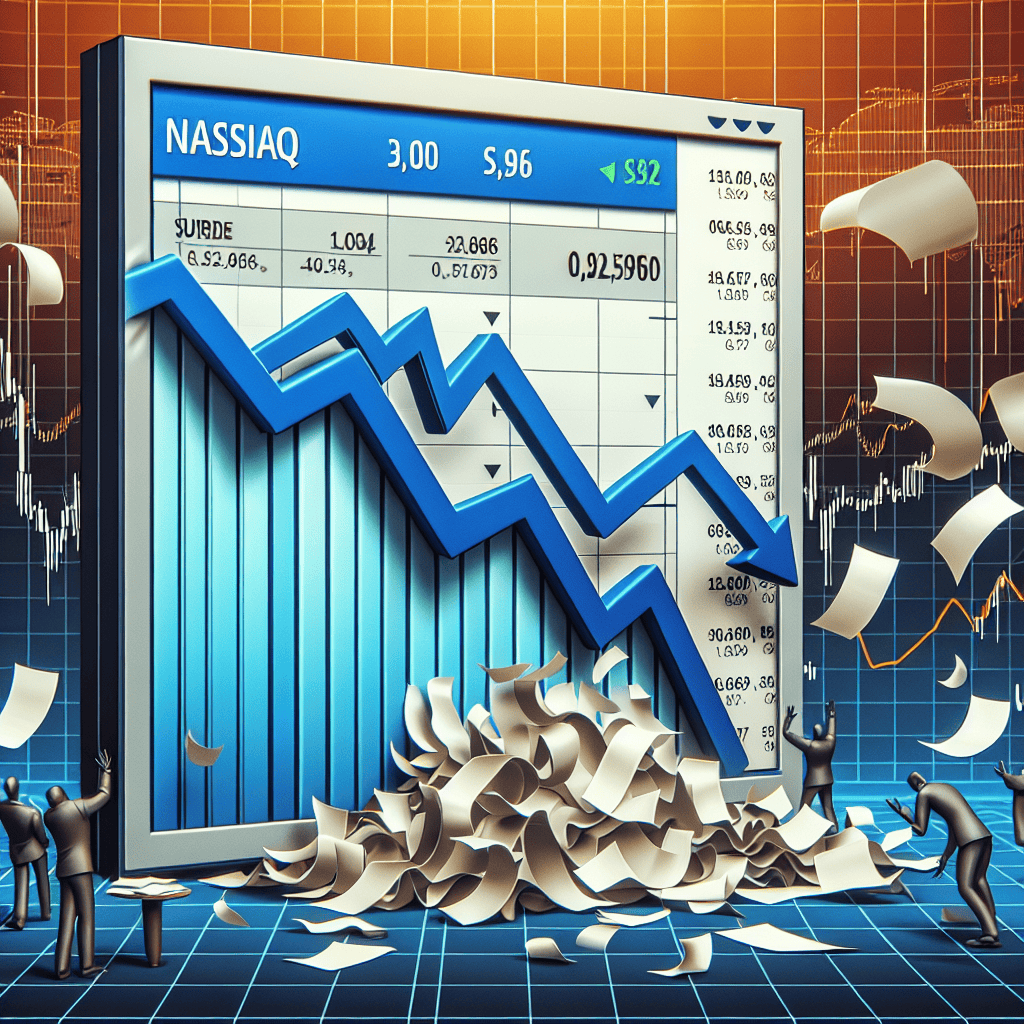“Nasdaq Tumbles: Earnings Surge, Markets Diverge”
Introduction
In recent market developments, the Nasdaq Composite Index has experienced a notable downturn, exerting downward pressure on broader stock market performance. This decline comes amid a surge in corporate earnings reports, which have presented a mixed bag of results, contributing to heightened market volatility. Investors are closely scrutinizing these earnings to gauge the health of various sectors and the overall economy, as concerns about inflation, interest rates, and global economic conditions persist. The Nasdaq’s performance, heavily influenced by technology and growth-oriented stocks, reflects the market’s current apprehensions and the complex interplay of factors shaping investor sentiment.
Impact Of Nasdaq’s Decline On Investor Sentiment
The recent decline in the Nasdaq Composite Index has sent ripples through the financial markets, significantly impacting investor sentiment. As one of the most closely watched indices, the Nasdaq’s performance often serves as a barometer for the broader technology sector and, by extension, the overall market. This downturn comes at a time when many companies are reporting their earnings, creating a complex landscape for investors to navigate. The juxtaposition of a declining index amid an earnings surge presents a unique challenge, as it forces investors to reconcile the apparent disconnect between market performance and corporate profitability.
To understand the impact of the Nasdaq’s decline on investor sentiment, it is essential to consider the composition of the index itself. The Nasdaq is heavily weighted towards technology and growth-oriented companies, which have been the darlings of the market in recent years. These companies, known for their innovation and rapid growth potential, have attracted significant investment, driving their valuations to unprecedented levels. However, the recent pullback in the Nasdaq suggests a shift in investor sentiment, as concerns over rising interest rates, inflation, and geopolitical tensions weigh heavily on the market.
As investors grapple with these macroeconomic factors, the earnings season has added another layer of complexity. Many companies have reported robust earnings, exceeding analysts’ expectations and demonstrating resilience in the face of economic headwinds. This earnings surge, while generally positive, has not been enough to offset the broader market concerns that are driving the Nasdaq lower. Consequently, investors are faced with a paradox: strong corporate earnings juxtaposed with a declining market index.
This paradox has led to increased volatility, as investors attempt to make sense of the conflicting signals. On one hand, strong earnings reports suggest that companies are performing well and are capable of navigating the current economic environment. On the other hand, the decline in the Nasdaq indicates that investors are wary of potential risks and are adjusting their portfolios accordingly. This cautious approach is reflected in the increased demand for safe-haven assets, such as bonds and gold, as investors seek to mitigate risk.
Moreover, the decline in the Nasdaq has broader implications for investor sentiment beyond the technology sector. As the index falls, it can create a ripple effect, influencing the performance of other sectors and indices. This interconnectedness means that even companies outside the technology sphere may experience pressure on their stock prices, as investors reassess their risk tolerance and reallocate their assets. The resulting market dynamics can lead to a self-reinforcing cycle, where declining stock prices further erode investor confidence, leading to additional selling pressure.
In conclusion, the decline in the Nasdaq amid an earnings surge has created a challenging environment for investors. The apparent disconnect between strong corporate earnings and a falling market index underscores the complexity of the current economic landscape. As investors navigate this environment, they must weigh the positive signals from earnings reports against the broader macroeconomic concerns that are driving market sentiment. This delicate balancing act will likely continue to shape investor behavior in the coming months, as market participants seek to reconcile these competing forces and chart a course forward.
Key Factors Behind Nasdaq’s Recent Downturn
The recent downturn in the Nasdaq Composite Index has captured the attention of investors and analysts alike, as it coincides with a period of robust earnings reports from major corporations. This apparent paradox has prompted a closer examination of the underlying factors contributing to the index’s decline. While earnings season typically brings a wave of optimism, the current market environment is shaped by a complex interplay of economic indicators, investor sentiment, and external pressures.
To begin with, the Nasdaq’s recent performance can be partly attributed to the broader macroeconomic landscape. Inflationary pressures have been a persistent concern, with central banks around the world grappling with the challenge of balancing economic growth and price stability. In the United States, the Federal Reserve’s monetary policy decisions have been closely scrutinized, as any indication of interest rate hikes can lead to market volatility. Higher interest rates tend to increase borrowing costs for companies, which can dampen corporate profits and, in turn, weigh on stock prices. Consequently, the anticipation of tighter monetary policy has contributed to the Nasdaq’s recent struggles.
Moreover, the technology sector, which constitutes a significant portion of the Nasdaq, has faced its own set of challenges. Despite strong earnings reports from tech giants, concerns about overvaluation have persisted. Many technology stocks have experienced substantial gains over the past few years, leading to elevated price-to-earnings ratios. As a result, investors have become increasingly cautious, fearing that these stocks may be overpriced relative to their fundamental value. This apprehension has led to profit-taking and a subsequent decline in stock prices, further dragging down the Nasdaq.
In addition to valuation concerns, regulatory pressures have also played a role in the Nasdaq’s downturn. Governments around the world are intensifying their scrutiny of major technology companies, focusing on issues such as data privacy, antitrust practices, and digital taxation. These regulatory challenges have created an atmosphere of uncertainty, as companies may face increased compliance costs and potential fines. The prospect of stricter regulations has made investors wary, contributing to the overall decline in technology stocks and, by extension, the Nasdaq.
Furthermore, geopolitical tensions have added another layer of complexity to the market environment. Trade disputes, particularly between the United States and China, have resurfaced, raising concerns about potential disruptions to global supply chains. Technology companies, which often rely on international markets for both production and sales, are particularly vulnerable to such disruptions. The uncertainty surrounding trade relations has led to increased market volatility, as investors attempt to navigate the potential impact on corporate earnings and growth prospects.
Despite these challenges, it is important to recognize that the Nasdaq’s downturn is not solely a reflection of negative factors. The market is inherently cyclical, and periods of correction are a natural part of its dynamics. While the current environment may seem daunting, it also presents opportunities for investors to reassess their portfolios and identify undervalued assets. As earnings season continues, market participants will be closely monitoring corporate guidance and economic indicators to gauge the potential for recovery.
In conclusion, the recent decline in the Nasdaq Composite Index is the result of a confluence of factors, including macroeconomic pressures, valuation concerns, regulatory challenges, and geopolitical tensions. While these elements have created a challenging environment for investors, they also underscore the importance of maintaining a long-term perspective and adapting to changing market conditions. As the landscape continues to evolve, staying informed and agile will be key to navigating the complexities of the current market.
How Earnings Surges Are Influencing Market Volatility
The recent fluctuations in the stock market have been a topic of intense discussion among investors and analysts alike, particularly as the Nasdaq Composite Index has experienced significant downturns. This decline comes at a time when many companies are reporting robust earnings, creating a paradoxical situation that underscores the complex dynamics of market volatility. Understanding how these earnings surges are influencing market behavior requires a closer examination of the interplay between investor expectations, economic indicators, and broader market trends.
To begin with, the earnings season has been marked by impressive performances from a variety of sectors, including technology, healthcare, and consumer goods. Companies have reported higher-than-expected profits, driven by increased consumer spending and operational efficiencies. These positive earnings reports typically serve as a catalyst for stock price appreciation, as they reflect the underlying strength and profitability of businesses. However, despite these encouraging financial results, the Nasdaq has been unable to sustain upward momentum, suggesting that other factors are at play.
One significant element contributing to this volatility is the heightened expectations that often accompany earnings season. Investors tend to anticipate strong performances, and when companies meet or exceed these expectations, the initial reaction is usually positive. However, if the broader economic context is uncertain or if there are concerns about future growth prospects, the market may react negatively. This is particularly true in the current environment, where inflationary pressures, interest rate hikes, and geopolitical tensions are creating a backdrop of uncertainty. As a result, even stellar earnings reports may not be sufficient to offset these broader concerns, leading to increased market volatility.
Moreover, the technology sector, which is heavily represented in the Nasdaq, has been particularly susceptible to these fluctuations. Tech stocks have enjoyed substantial gains over the past few years, driven by innovation and the accelerated digital transformation across industries. However, they are also more sensitive to changes in interest rates and economic conditions. As central banks around the world signal tighter monetary policies to combat inflation, the cost of capital for tech companies is expected to rise, potentially impacting their growth trajectories. This anticipation of future challenges can lead to sell-offs, even in the face of strong current earnings.
In addition to these factors, the interconnectedness of global markets means that external events can have a pronounced impact on domestic indices like the Nasdaq. For instance, supply chain disruptions, trade tensions, and political instability in key regions can all contribute to market uncertainty. Investors, therefore, must navigate a complex web of influences that extend beyond individual company performances. This interconnectedness amplifies the effects of earnings reports, as positive or negative news can ripple through the market, affecting investor sentiment and stock prices.
In conclusion, while earnings surges are generally seen as positive indicators of corporate health, their influence on market volatility is far from straightforward. The current environment, characterized by high expectations, economic uncertainty, and global interconnectedness, means that even strong earnings may not be enough to stabilize markets like the Nasdaq. Investors must remain vigilant, considering not only the financial performance of individual companies but also the broader economic and geopolitical landscape. As such, understanding the nuanced relationship between earnings and market volatility is crucial for making informed investment decisions in these turbulent times.
Sector Analysis: Which Industries Are Most Affected By Nasdaq’s Drop?

The recent downturn in the Nasdaq Composite Index has sent ripples across various sectors, prompting investors and analysts to reassess their strategies amid a surge in corporate earnings. As the Nasdaq, heavily weighted with technology stocks, experiences a decline, it is crucial to understand which industries are most affected and how they are navigating this challenging landscape. The technology sector, unsurprisingly, bears the brunt of the Nasdaq’s drop. Companies within this sector, particularly those involved in software, semiconductors, and digital services, have seen their stock prices fluctuate significantly. This volatility can be attributed to a combination of factors, including rising interest rates, regulatory pressures, and concerns over valuations that had previously soared to unprecedented levels. As a result, tech companies are now under increased scrutiny, with investors closely monitoring their earnings reports for signs of resilience or further vulnerability.
Transitioning to the financial sector, the impact of the Nasdaq’s decline is somewhat mixed. On one hand, banks and financial institutions benefit from rising interest rates, which can enhance their profit margins. However, the broader market uncertainty and potential slowdown in economic growth pose challenges. Investment firms with significant exposure to technology stocks may face headwinds, as their portfolios are directly affected by the Nasdaq’s performance. Consequently, financial analysts are keenly observing earnings reports from major banks to gauge their adaptability in this fluctuating environment.
Meanwhile, the consumer discretionary sector is also feeling the effects of the Nasdaq’s downturn. Companies in this sector, which includes retail, travel, and leisure, are particularly sensitive to changes in consumer sentiment and spending power. As technology stocks decline, there is a potential for reduced consumer confidence, which could lead to decreased spending on non-essential goods and services. Retailers and travel companies, therefore, are closely monitoring consumer behavior and adjusting their strategies to maintain profitability amid these uncertainties.
In contrast, the healthcare sector appears to be more insulated from the Nasdaq’s fluctuations. While some biotech firms with high valuations may experience stock price volatility, the overall demand for healthcare services remains robust. The sector’s defensive nature, coupled with ongoing innovations and an aging population, provides a buffer against broader market downturns. As a result, healthcare companies continue to report strong earnings, attracting investors seeking stability in turbulent times.
Furthermore, the energy sector is experiencing its own set of dynamics, somewhat independent of the Nasdaq’s performance. With global energy demand rebounding and geopolitical tensions influencing supply chains, energy companies are witnessing a surge in earnings. This sector’s resilience is further bolstered by the ongoing transition to renewable energy sources, which presents both challenges and opportunities for traditional energy firms. Investors are thus paying close attention to how these companies are positioning themselves for long-term growth amid the current market conditions.
In conclusion, the Nasdaq’s recent decline has had varying impacts across different sectors, with technology and consumer discretionary industries facing significant challenges, while healthcare and energy demonstrate relative resilience. As corporate earnings continue to surge, investors are tasked with navigating this complex landscape, balancing the potential risks and rewards associated with each sector. By closely analyzing earnings reports and market trends, stakeholders can make informed decisions to optimize their portfolios in response to the evolving economic environment.
Strategies For Investors During Nasdaq’s Bearish Trends
In the ever-evolving landscape of financial markets, investors are constantly seeking strategies to navigate the complexities of stock market fluctuations. Recently, the Nasdaq has been a focal point of concern as it drags stocks down amid a surge in earnings reports. This scenario presents a unique challenge for investors, who must adapt their strategies to mitigate risks and capitalize on potential opportunities. Understanding the underlying factors contributing to the Nasdaq’s bearish trends is crucial for formulating effective investment strategies.
To begin with, the Nasdaq’s recent downturn can be attributed to a confluence of factors, including macroeconomic uncertainties, rising interest rates, and geopolitical tensions. These elements have collectively created a volatile environment, prompting investors to reassess their portfolios. In such times, diversification emerges as a fundamental strategy. By spreading investments across various sectors and asset classes, investors can reduce their exposure to the volatility of any single market segment. This approach not only mitigates risk but also positions investors to benefit from potential gains in other areas of the market.
Moreover, during periods of bearish trends, it is essential for investors to maintain a long-term perspective. While short-term market fluctuations can be unsettling, history has shown that markets tend to recover over time. By focusing on long-term goals and maintaining a disciplined investment approach, investors can avoid making impulsive decisions driven by fear or panic. This strategy involves sticking to a well-defined investment plan and resisting the urge to time the market, which is notoriously difficult even for seasoned investors.
In addition to diversification and a long-term outlook, investors should consider the role of defensive stocks in their portfolios. Defensive stocks, typically found in sectors such as utilities, healthcare, and consumer staples, tend to be less sensitive to economic cycles. These stocks can provide stability and consistent returns, even during market downturns. By incorporating defensive stocks into their portfolios, investors can create a buffer against the volatility of more cyclical sectors, thereby enhancing the resilience of their investments.
Furthermore, the current earnings surge presents both challenges and opportunities for investors. While some companies may report strong earnings, others may fall short of expectations, leading to significant stock price fluctuations. In this context, conducting thorough research and analysis becomes paramount. Investors should focus on companies with solid fundamentals, strong balance sheets, and a track record of consistent performance. By identifying such companies, investors can make informed decisions and potentially capitalize on undervalued stocks that have been unjustly punished by the broader market sentiment.
Additionally, it is important for investors to stay informed about macroeconomic indicators and central bank policies. Changes in interest rates, inflation trends, and fiscal policies can have a profound impact on market dynamics. By keeping abreast of these developments, investors can better anticipate potential market shifts and adjust their strategies accordingly. This proactive approach allows investors to remain agile and responsive in an ever-changing market environment.
In conclusion, navigating the Nasdaq’s bearish trends amid an earnings surge requires a multifaceted approach. By embracing diversification, maintaining a long-term perspective, incorporating defensive stocks, conducting thorough research, and staying informed about macroeconomic factors, investors can effectively manage risks and seize opportunities. While market volatility is an inherent aspect of investing, a well-considered strategy can help investors weather the storm and achieve their financial objectives.
Historical Comparisons: Nasdaq’s Performance During Earnings Seasons
The Nasdaq Composite Index, a benchmark for technology and growth-oriented stocks, has historically exhibited a unique pattern during earnings seasons. This period, when publicly traded companies report their quarterly financial results, often brings heightened volatility to the stock market. As investors digest a flurry of earnings reports, the Nasdaq’s performance can serve as a barometer for broader market sentiment, particularly in sectors driven by innovation and technological advancement.
Historically, the Nasdaq has shown a tendency to react more dramatically to earnings announcements compared to other major indices like the S&P 500 or the Dow Jones Industrial Average. This heightened sensitivity can be attributed to the composition of the Nasdaq, which is heavily weighted towards technology and internet-based companies. These sectors are often subject to rapid changes in investor sentiment based on earnings results, guidance, and broader economic indicators. Consequently, during earnings seasons, the Nasdaq can experience significant swings, either upward or downward, depending on the collective performance of its constituent companies.
In examining past earnings seasons, it becomes evident that the Nasdaq’s performance is not solely dependent on the results of individual companies but also on the overall economic environment. For instance, during periods of economic expansion, strong earnings reports from major tech firms can propel the Nasdaq to new heights, reflecting investor optimism about future growth prospects. Conversely, in times of economic uncertainty or contraction, even robust earnings may not be sufficient to buoy the index if investors are concerned about broader market conditions.
Moreover, the Nasdaq’s reaction to earnings can also be influenced by external factors such as interest rate changes, geopolitical events, and regulatory developments. For example, during periods of rising interest rates, growth stocks, which are prevalent in the Nasdaq, may face additional pressure as investors reassess their valuations. Similarly, geopolitical tensions or regulatory crackdowns on major tech companies can introduce additional volatility, overshadowing positive earnings results.
Despite these challenges, the Nasdaq has demonstrated resilience over the long term, often rebounding strongly after periods of volatility. This resilience can be attributed to the innovative nature of its constituent companies, which are frequently at the forefront of technological advancements and industry disruption. As a result, even when the Nasdaq drags stocks down during earnings seasons, it often recovers as investors regain confidence in the growth potential of the technology sector.
In comparing the Nasdaq’s performance during earnings seasons to other indices, it is important to consider the unique characteristics that define it. While the S&P 500 and Dow Jones Industrial Average are more diversified across various sectors, the Nasdaq’s concentration in technology and growth stocks makes it more susceptible to the ebbs and flows of investor sentiment in these areas. Consequently, the Nasdaq’s performance during earnings seasons can serve as a leading indicator of market trends, particularly in the technology sector.
In conclusion, the Nasdaq’s historical performance during earnings seasons underscores its role as a dynamic and influential component of the stock market. While it may experience heightened volatility due to its concentration in technology and growth stocks, its long-term resilience and capacity for innovation continue to attract investor interest. As earnings seasons unfold, the Nasdaq remains a critical gauge of market sentiment, reflecting both the challenges and opportunities inherent in the ever-evolving landscape of the global economy.
Expert Predictions: Future Outlook For Nasdaq Amid Earnings Fluctuations
As the financial markets continue to navigate the complexities of a post-pandemic world, the Nasdaq Composite Index has recently experienced a downturn, even as corporate earnings reports show a surge in profitability. This paradoxical situation has left investors and analysts pondering the future trajectory of the Nasdaq, particularly in light of fluctuating earnings and broader economic uncertainties. To understand the potential outlook for the Nasdaq, it is essential to consider several key factors that are currently influencing market dynamics.
Firstly, the recent decline in the Nasdaq can be attributed to a combination of profit-taking and concerns over valuation. After a prolonged period of robust gains, many investors are opting to lock in profits, leading to downward pressure on stock prices. Additionally, the high valuations of technology stocks, which constitute a significant portion of the Nasdaq, have raised questions about their sustainability in the face of rising interest rates. As central banks around the world signal a shift towards tighter monetary policy to combat inflation, the cost of borrowing is expected to increase, potentially dampening the growth prospects of high-flying tech companies.
Moreover, the earnings surge observed across various sectors has not been uniformly distributed, with some companies outperforming expectations while others struggle to meet them. This uneven performance has contributed to increased volatility in the Nasdaq, as investors reassess their portfolios in response to the latest earnings reports. Companies that have successfully adapted to changing consumer behaviors and supply chain disruptions have generally fared better, while those that have been slow to innovate or diversify their offerings have faced greater challenges.
In addition to these immediate concerns, longer-term structural shifts are also at play. The ongoing digital transformation of industries, accelerated by the pandemic, continues to drive demand for technology solutions, which bodes well for the Nasdaq’s future growth potential. However, this transformation is accompanied by heightened competition and regulatory scrutiny, particularly in areas such as data privacy and antitrust. As governments around the world seek to balance innovation with consumer protection, the regulatory landscape for tech companies is likely to evolve, introducing new risks and opportunities for investors.
Furthermore, geopolitical tensions and global supply chain disruptions remain significant factors that could impact the Nasdaq’s performance. The interconnected nature of the global economy means that events such as trade disputes, political instability, or natural disasters can have far-reaching effects on market sentiment and corporate earnings. As such, investors must remain vigilant and adaptable, ready to respond to both anticipated and unforeseen challenges.
Looking ahead, expert predictions for the Nasdaq suggest a cautious yet optimistic outlook. While short-term volatility is expected to persist, driven by earnings fluctuations and macroeconomic factors, the long-term growth prospects for technology and innovation remain strong. Investors are advised to adopt a balanced approach, focusing on companies with solid fundamentals, competitive advantages, and the ability to navigate an evolving landscape.
In conclusion, the future outlook for the Nasdaq amid earnings fluctuations is shaped by a complex interplay of factors, including valuation concerns, earnings performance, regulatory developments, and geopolitical risks. By staying informed and agile, investors can position themselves to capitalize on opportunities while mitigating potential downsides. As the market continues to evolve, the Nasdaq’s journey will undoubtedly be marked by both challenges and triumphs, reflecting the dynamic nature of the global economy.
Q&A
1. **What caused the Nasdaq to drag stocks down?**
– The Nasdaq was dragged down due to a combination of disappointing earnings reports from major tech companies and broader market concerns.
2. **Which companies’ earnings reports impacted the Nasdaq?**
– Earnings reports from major tech companies like Apple, Amazon, and Microsoft significantly impacted the Nasdaq.
3. **How did the earnings surge affect investor sentiment?**
– The earnings surge created mixed investor sentiment, with some investors concerned about future growth prospects despite strong current earnings.
4. **What sectors were most affected by the Nasdaq’s decline?**
– The technology and communication services sectors were most affected by the Nasdaq’s decline.
5. **Did any sectors perform well despite the Nasdaq’s decline?**
– Defensive sectors such as utilities and consumer staples performed relatively well despite the Nasdaq’s decline.
6. **How did global markets react to the Nasdaq’s performance?**
– Global markets showed mixed reactions, with some international indices experiencing declines while others remained stable or saw slight gains.
7. **What are analysts predicting for the Nasdaq’s future performance?**
– Analysts have mixed predictions, with some expecting a rebound as companies adjust forecasts, while others anticipate continued volatility due to economic uncertainties.
Conclusion
The Nasdaq’s decline amid a surge in earnings highlights a complex market environment where strong corporate performance is overshadowed by broader concerns. Despite robust earnings reports, factors such as rising interest rates, inflationary pressures, or geopolitical tensions may be contributing to investor caution, leading to a sell-off in tech-heavy indices like the Nasdaq. This scenario underscores the disconnect that can occur between company fundamentals and market sentiment, suggesting that investors are weighing potential risks more heavily than positive earnings news. As a result, the market’s reaction reflects a cautious outlook, prioritizing macroeconomic uncertainties over individual corporate successes.





